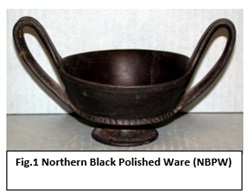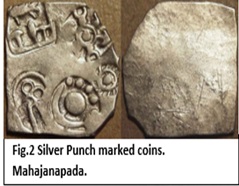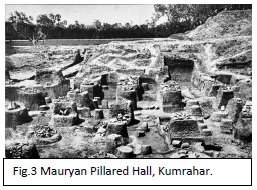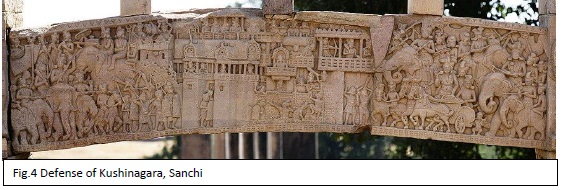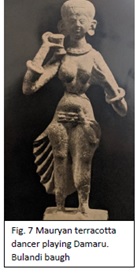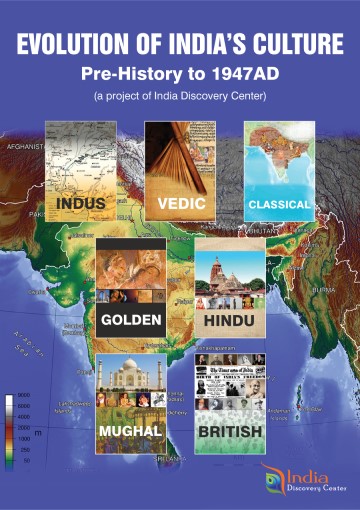India Classical period (700BCE-200BCE) – Art and Culture
Archeologically, the famed Northern Black Polished Ware (NBPW) pottery with a burnished and glazed surface, marks the second phase of urbanisation. Large hoards of silver and copper punch marked Karshapana-standard coins from the historic Mahajanapadas (City States) with distinct iconography, have also been recovered.
Pali texts mention Puras (fortified citadel city), Nagaras (fortress town), Nigamas (market town), Rajdhani (capital) and Mahanagaras (metropolitans like Champa, Shravasti, Rajgriha, Varanasi) with gates, walls, moats, and watchtowers. Remains of the fortified boundaries of Rajgriha, a garden city with central core surrounded by numerous parks have been excavated.
A Sanchi Stupa frieze shows Kushinagara during a battle, with 3 or more storied vaulted buildings with horse-shoe shaped crowning facade supported by wooden buttresses, carved railings and viewing galleries. Megasthenes describes Chandragupta Maurya’s luxurious timber-made palace with gilded wooden columns ‘adorned with golden vines and silver birds’, colored walls, and painted frescoes, at Kumrahar (Pataliputra).
Mauryan royalty wore fine muslin cloth embroidered with purple and gold (brocade) with precious stones and flower ornamentations. Mahabharata mentions ‘Chitravastra’ (printed cloth), while fine Indian cotton, silk, linen and woollen cloth were famous in Persian, Turkish and European markets (Greek accounts). Silk cocoons reached India from China (Chinnapatta -Arthashastra) through Burma, into Bengal and Assam where the silk industry developed.
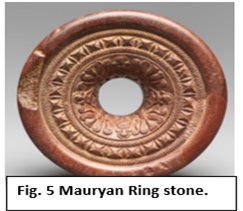
Town markets sold luxury items like - oils, perfumes, jewelry, and liquors. Lac-insects for Shellac jewelry and lacquer for timber, and ‘lake’ or organic dye was widely cultured. Ivory workers and metal smith were highly sought-after. Materials found at NBPW levels include terracotta animal and human figurines, broken ivory, sculpted ringstones, terracotta seals, bone arrowheads and simple stamped pottery.
Pali and Jain literature mention theatrical and musical performances at royal courts, fairs, and festivals. The actors, dancers, bards, musicians, drummers, acrobats, and magicians traveled from villages to towns. Jatakas mention plays, musical theatre, plays on open circular stage and even ‘women’s theatre’. Plots of these folk theatres inadvertently recorded actual historical events later recovered from Sanskrit plays, like Chandragupta Maurya’s victory of Magadha (Vishakhadatta’s ‘Mudrarakshasa’). Panini mentions Nata-sutras (performance manual) authored by Shilalin and Krishshva, as well as famous Veena, venu, mridanga players.
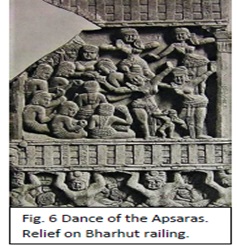
The most accomplished dancer excelling in all arts, literature and mathematics held the official post of Janapadakalyani (high courtesan and state host), like the celebrated Ambapali of Vaishali who met and was deeply influenced by Buddha. Kavya (poetic storytelling) literature started around 500 B.C. that encouraged inclusion of beautiful descriptions of cities, bucolic settings, and forest ashrama scenes.
In late Mauryan period Ashoka pioneered mastery of stone masonry with the earliest rock cut caves and Chaitya halls (Barabar caves), Buddhist stupas (Sanchi, Bharhut) and numerous pillars and stone edicts built extensively across the realm spreading the message of Buddhism and proper governance. Ashoka’s emissaries to Sri Lanka, Burma and Thailand initiated the spread of Buddhism to SE Asia.
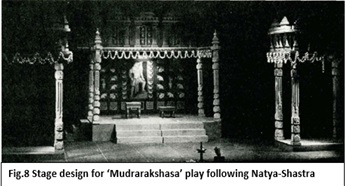
Earliest stupas were a simple brick hemispherical dome placed on a circular base, crowned with a square box and a Chhatri (umbrella). Some featured a railing or wall. The jewels of Mauryan art and craftsmanship are the innumerable intricately designed stone rings and monolithic free standing sandstone pillars called the Dhamma stambha (Pillar of Dhamma) of Ashoka, consisting of a long polished columnar shaft (some with edicts), and a capital of mostly a single animal seated on a circular abacus with an inverted lotus below it. This design has Greek and Persian influence. Stone surfaces of the pillars, rock cut cave walls, monolithic Stupa railings, carried the smoothened metallic shine of the famed Mauryan polish technique.
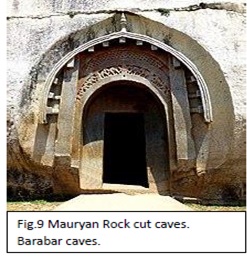
The most elaborate capital belongs to the Sarnath pillar, with 4 asiatic lions seated facing outwards balancing a 32 spoke Dhamma-Chakra atop them, with four 24 spoke wheels interspersed with 4 animals (lion, elephant, bull and horse) etched on the abacus. Its symbolism, beauty and craftsmanship make it the emblem of modern India.
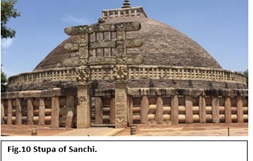
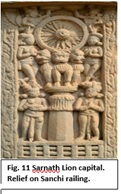
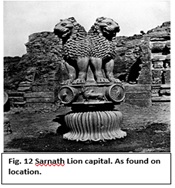
References:
1. A
History of Ancient and Medieval India. Upinder Singh. 2018 impression.
2. The
Wonder that was India. A.L. Basham. 3rd edition.
3. The
Civilisation of India. R.C. Dutt.1995
4. INDIA.
An Archeological History. Paleolithic History to Early Historic Foundations.
D.K, Chakrovarty. 2nd Edition.
6. The
archeology of early historic South Asia. F.R Allchen. 1995.
7. Ancient
Indian and Indo-Greek theatre. M L Varadpande. 1981
8. Epic
India or India as described in The Mahabharata and The Ramayana. C.V. Vaidya.
1097.
Sanskrit, Pali Terms
Kappasikam
(cotton), Kosseyam (silk), Khoman (linen)
Dantakara (Ivory
worker), Kammakara (metal smith)
Natas
(actor), Nartakas(dancer), Gayakas(singer), Vaitalikas(bard), Mayakaras
(magician), Langhikas (acrobat), Kumbhathunikas (drummer)
Nataka
(plays), Pathya (musical theatre), Samajja (plays on circular stage),Stree preksha
(women’s theatre).
Veena
(lute), venu (flute), mridanga (percussion)
------------------------------------------------------------------------------------------
Dr. Krishnakali Dasgupta leads the Art and
Culture track in India Discovery Center's project on "Evolution of Indian
Culture: Pre-history to 1947AD"
More information and updates on the project are
available at
https://www.facebook.com/Evolution-of-Indian-Culture-An-IDC-Project-107749391111922
More information on India Discovery Center is
available at https://www.indiadiscoverycenter.org
(c)
Copyright 2021 India Discovery Center, Inc.
All rights reserved.